The hardest cars to write about – and to buy – are crossover SUVs. Which to pick? What to say? So many . . . so alike.
It’s like shopping for refrigerators.
VW’s Tiguan being an exception to this rule. Smaller than the others in its class – up to now – but with more engine. A standard turbocharged engine. The early models could even be ordered with a manual transmission – which was like finding a real diamond ring at the bottom of your Cracker Jack box.
It was actually fun to drive, not just another appliance that you bought because it had cargo room and cupholders.
And it had upmarket cachet.
A bit more than a run-of-the-mill RAV4 or CR-V. Nicer materials inside. Quieter and more refined. That Audi kinship.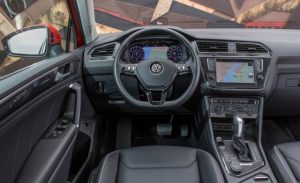
But, it lacked room. The back seat was tight – and there wasn’t much cargo room vs. the utilitarian appliances that are its main cross shops.
Well, that’s been fixed.
And with a twist.
WHAT IT IS
The Tiggy (it’s easier to pronounce) is VW’s “compact” crossover SUV. Like its main cross-shops, models like the Toyota RAV4, the Honda CR-V and Subaru Forester, it is nearly mid-sized now, in all but name.
Unlike its cross-shops, the Tiggy is powerful as it comes – because it comes standard with a turbocharged engine. The CR-V and Forester can be ordered with one – but you pay extra.
In the case of the Subaru, a lot extra.
The RAV4 doesn’t offer one at all.
And, you can get a third row now, too. The RAV4, CR-V and Forester are two-row-only deals. Same goes for the just-downsized Chevy Equinox. Which does come standard with a turbocharged engine, but Chevy makes you pay for through the nose to get it with AWD.
The Tiggy is also the only one it is class/price range that’s close kin to luxury-brand German cars.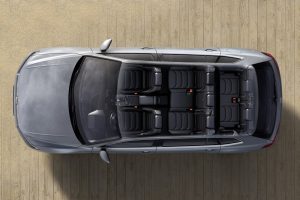
Base price is $25,345 for a front-wheel-drive S trim; with 4Motion all-wheel-drive, the MSRP upticks to $26,645.
A top-of-the-line SEL trim with a digital LCD dash, eight-inch touchscreen, 480 watt/nine-speaker Fender audio rig and 4Motion AWD stickers for $37,550.
The Toyota RAV4 starts at $24,410 – and there is no upgrade engine or third row seat option.
Honda’s CR-V offers a turbocharged engine, but it costs extra – $26,795 to start vs. $24,045 for the base-engined/no-turbo (and not much go) version. No third row row, either.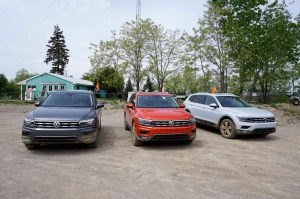
The Subaru Forester offers a turbo engine – but the sticker price for that version is $29,495 (but it does come standard with AWD).
The Chevy Equinox comes standard with a turbocharged engine, and its sticker price to start is $23,580. But if you want AWD, you have to buy the more expensive LS trim, which starts at $27,260. The Equinox is also smaller – and does not offer a third row option.
The works.
The ’18 Tiggy is almost a foot longer than the old model, offers a third row seating option and is powered by a heavily revised version of VW’s 2.0 liter turbocharged four cylinder engine, tuned to produce more low-end torque. An eight-speed automatic transmission replaces last year’s six-speed automatic and though the ’18 Tiggy is larger and heavier, its gas mileage is actually slightly better than the outgoing model’s.
WHAT’S GOOD
Standard turbo engine; most cross-shops either don’t offer it – or charge extra for it.
Available third row option; most cross-shops don’t offer it at all.
More than twice the old Tiggy’s cargo capacity.
Optional four-mode 4Motion AWD is more capable than cross-shop’s one-mode-only AWD systems.
WHAT’S NOT SO GOOD
Chevy is going to offer a 40 MPG-capable diesel in the Equinox. VW isn’t going to offer a diesel at all.
Reduced towing capacity vs. last year (1,500 lbs. max, vs. 2,200 lbs. previously).
Obnoxious auto-stop/start system.
Most people tend to focus on horsepower. The more the better.
The fact that there is less of it under the hood of the rebooted 2018 VW Tiguan – which is also a larger and heavier Tiguan than the outgoing model – seems initially alarming.
184 hp out of the 2.0 liter turbocharged engine now – vs. 200 hp last year. Meanwhile, the longer-by-a-foot (almost) and heavier by several hundred pounds (for a fact) 2018 Tiggy itself. It sounds like a recipe for The Slows.
But then, there is torque.
And it is torque which gets a car moving initially. Which makes it feel not-slow when you first push down on the accelerator. Torque – a measure of rotational force – is the thing.
And the new Tiggy has more of that.
221 ft.-lbs. now – vs. 207 ft.-lbs. last year.
Sooner, too. The tweaked-for-2018 2.0 liter engine generates its maximum torque at 1,600 RPM vs. 1,700 RPM for the 2017 Tiggy. Peak torque is maintained all the way through 4,300 RPM, too.
And it’s all paired up with a new eight-speed automatic transmission, the extra gears (vs. last year’s six-speed) providing a bit more mechanical leverage in the lower ranges especially, enhancing the increased (and more accessible) torque output.
Most of the Tiggy’s immediate (price-equivalent) rivals can’t touch this.
The Toyota RAV4 costs about the same but maxes out at 176 hp (and a lot less torque). It is slow. Ten seconds to 60 – and there’s no optional engine you can resort to.
The Honda CR-V costs more when equipped with its available turbo engine (1.5 liters) but it doesn’t make as much torque (just 179 ft.-lbs. and not until 2,000 RPM) and takes longer to get to 60 than the less-pricey (and more potent) turbo’d Tiggy.
A turbo’d Forester is stronger – and quicker – and costs about $4k more. With no third row.
You can go with front-wheel-drive or (optionally) all-wheel-drive, as is true of the other crossovers in this class. But the Tiggy’s available 4Motion AWD system has four driver-selectable terrain settings, including snow and mud, which the others do not offer. The VW system also decouples the rear wheels, allowing them to freewheel during light-load conditions/when there is no loss of traction up front. Most other AWD systems keep all four wheels engaged at least to some degree – even when there is no loss of traction.
All of this results in a mileage increase over last year – despite the increased size and curb weight: 22 city, 27 highway for FWD models and 21 city, 27 highway for models equipped with the optional 4Motion AWD system.
Last year’s Tiggy – smaller and lighter – rated 20 city, 24 highway.
And – notwithstanding the turbo and high (11.7:1) compression – the Tiggy’s engine is a regular fuel engine. This is a pretty big deal, which you’ll already know about if you’ve gassed up lately. While regular unleaded is hovering around $2.10 a gallon, premium often costs 20 to even 50 cents more per gallon. It’s not chump change. And it adds up.
The Tiggy’s maximum tow rating is only 1,500 lbs. – but this is par for the class. It’s enough to pull a small trailer.
The key thing to grok is not that the new Tiggy hasn’t lost a step vs. the old Tiggy (it hasn’t; the 2018 and the 2017 both get to 60 in the mid-sevens) but that the new one feels lighter on its feet – even though it is bigger and heavier.
See that stuff above about the the torque. It is like the Schwarz in the movie, Spaceballs – if you get the reference. And it used to be what so many people really liked about American cars with their big V8 engines. The effortless thrust. The not having to stomp on the gas to get going.
The Tiggy’s turbo simulates the Big Engine Experience pretty convincingly. It’s almost never necessary to floor it. All that torque is right there, right now. A quarter to half-pedal is usually all you need.
All that’s missing is the V8 rumble.
Another thing about the Tiggy is the fact that its automatic isn’t a continuously variable (CVT) automatic. VW didn’t resort to a CVT to up the MPGs – which is the main (and arguably, only) reason many other manufacturers have gone to CVTs over traditional automatics. The difference being that CVTs don’t shift but kind of transition through an infinite range of ratios. This is good for gas mileage because it keeps the engine operating at the right spot in its powerband for maximum MPGs. But it’s not so good for operating characteristics – which are sometimes noisy.
A CVT will, for example, let an engine rev to high RPM – where (usually) – it makes peak power. And will hold it there, until you back off the gas pedal. A conventional automatic will shift through gears, engine RPM going down as you go up in gears. This is why conventional automatics are quieter, even if somewhat less economical.
The “CVT Effect” is magnified when the engine is a bit less than you probably need to comfortably haul the vehicle around – as in the CR-V, for instance. You get slow – and noisy.
The Tiggy is quick – and quiet.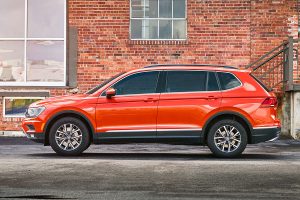
Sight-lines are good, which is becoming unusual. Mostly because of government “safety” mandates that have made it “safer” to be involved in a wreck but which have also made it more likely you’ll be in a wreck. Because of atrocious rearward and to-the-side visibility, caused by girder-thick roof supports and abbreviated side/rear glass. You can see what’s going on around you from within a Tiggy – and that’s arguably a more meaningful safety feature than whether the roof can support the weight of the thing if you roll it on its back.
AT THE CURB
VW not only decided to upsize the Tiggy, they decided to one-up the competition. The ’18 Tiggy is 185.1 inches long overall vs. 174.5 for the 2017 – a 10.6 inch stretch. This makes it slightly larger overall than rivals like the RAV4 (183.5 inches) CR-V (180.6 inches) Forester (181.5 inches) and Equinox (183.1 inches). Models which – in the past – it had been unfavorably compared with as far as being smaller and less roomy inside.
The previous Tiggy had a tight back seat (35.8 inches) and less cargo capacity than the others (23.8 cubic feet behind its second row; 56.1 cubes with the second row folded flat). This made it less practical than those others – which probably cost VW sales, even if reluctantly. These vehicles are, after all, fundamentally family vehicles. Turbo or not, fun or not – they need to be family friendly.
The new, upsized Tiggy gains almost an inch of second row legroom (36.5 inches) and more than doubles its cargo capacity. There is now 37.6 cubic feet of space behind the second row and 65.7 cubic feet with the second row folded flat.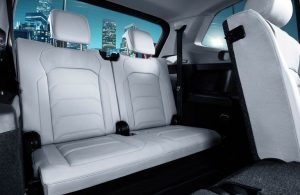
And, there is an available third row – something the others haven’t got. This could be the Tiggy’s trump card. It doesn’t really matter that it’s a tight third row. What matters – if you have kids, especially – is that you can carry six people (plus the driver) in a Tiggy and you can only carry four (plus the driver) in the others.
Practical – and still fun.
Lux, too.
You can get a full-length panorama sunroof (with ambient lighting, for effect) and a Digital Cockpit Display in the Tiggy. This latter is seriously uptown, similar to the flat-screen displays you find in six figure sleds like the current Mercedes S-Class, BMW 7 and Audi A8.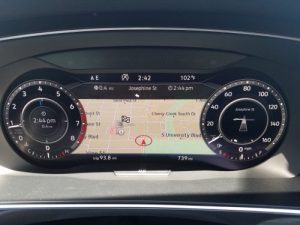
Another uptown feature is the Composition Color LCD display (eight inches) in the center stack. It is not only uber-chic in appearance, it does things like display JPEG pics piped in from your cell phone and text messages (send and receive) so you don’t have to use your cell phone while driving.
The satellite radio also features real-time record/playback, so if you hit a dead spot and lose the signal (and a portion of what you were listening to) just rewind and play it back.
Ausgezeichnet!
One other action item: The new Tiggy comes standard with almost as much ground clearance (7.9 inches) as a Subaru Forester. It also has an “off road” bumper and a 26 degree angle of approach and a 23 degree angle of departure.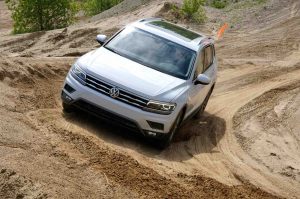
This will give Subaru night sweats.
THE REST
Two things about the Tiggy that are not improved:
First, the maximum tow rating – which used to be among the highest you could get in this class – is now (at best) par for the class. It’s been notched down to 1500 lbs. from 2,200 lbs. previously. The loss of tow weight is probably the result of the new Tiggy’s higher curb weight; in effect, the pounds you can’t pull behind you, you now carry around with you.
The other thing is the absence of a TDI (diesel) option. This sucks – literally. As laudable as the new Tiggy’s upticked mileage is, its still not as good as it would be with a diesel under the hood.
And with a diesel under the hood, the Tiggy would probably be able to pull 3,500 lbs.
VW used to be the go-to brand for affordable diesel-powered vehicles. Not anymore. The “cheating” scandal put the kibosh on that and – meanwhile – Chevy is going to offer a 40-plus MPG diesel option in the Equinox later this year or early next spring.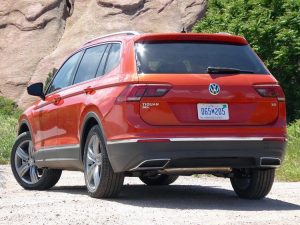
It’s like handing the gold medal for the triathalon to the guy who didn’t win it.
Oh. One other thing. The auto stop-start thing. More and more new cars come with this “feature.” It kills the engine when you come to a stop and then restarts it – automatically – when you take your foot off the brake and push on the gas pedal.
But in the new Tiggy, there’s a twist. Come to a stop – as when you’re parking and about to leave the car – and you find yourself accidentally restarting the already-stopped engine. You push the button to kill the engine – but it’s already been automatically stopped, because you did. Now you just re-started it.
Argh!
THE BOTTOM LINE
The diesel downer notwithstanding, the Tiggy still trumps its rivals on standard engine (and power), that available third row and that German near-lux experience – for about the same (or less) money than rivals are asking for less of all those qualities.
If you like what you’ve found here, please consider supporting EPautos.
We depend on you to keep the wheels turning!
Our donate button is here.
If you prefer not to use PayPal, our mailing address is:
EPautos
721 Hummingbird Lane SE
Copper Hill, VA 24079
PS: EPautos stickers are free to those who send in $20 or more to support the site. Also, the eBook – free! – is available. Just enter you email in the box on the top of the main page and we’ll send you a copy ASAP.


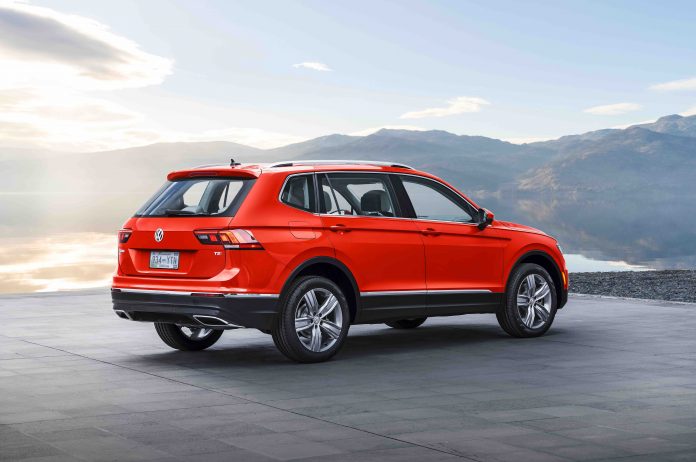


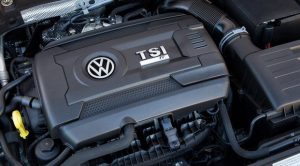
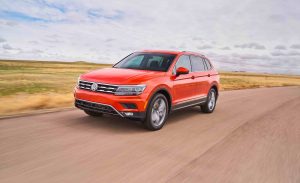
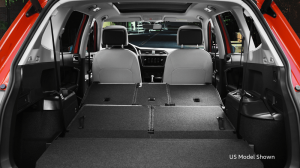






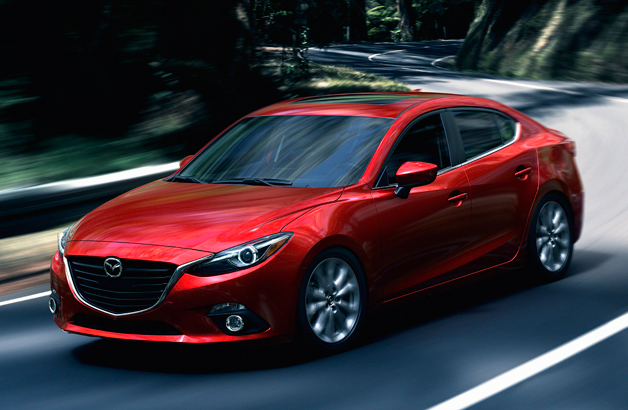
I almost bought one of these, they rock, very fun to drive, crisp precise steering perfectly weighted. I am addicted to VW steering, never vague, always spot on. Good steering make you a better driver as you cet feedback form the wheels, unlike the Japanese brands that try to isolate you as much as possible from driving dynamics. I don’t fault them for this they have been successful with that tactic marketing to Americans who are only interested in appliances not cars in the European sense. This is on reason why in the UK and France it seems that about every other car there is a VW or an Audi of some form.
The Tiggy alas was a bit too small for my needs, but the Tourmaline Blue Atlas was PERFECT for my needs.
This car is amazing actually. It feels like you are driving a Golf! This is not a negative! My wife could never drive my old Tahoe but she is delighted with the Atlas. The thing feels small, has maneuverability that would shame many smaller “sporty” cars, and the room OMG the room! The back seat is cavernous, I can put my drivers seat all the way back and middle seat passengers can recline and cross their legs all with someone in the 3rd row, and with the third row up, there is still adequate if not generous room for bags behind those seats.
I just did my first 400 mile round trip with it yesterday and the Atlas is joy on the highway, the V6 has great torque and power smoothly delivered. the steering is as smooth as an old Nikon 35mm lens focusing ring, mercury smooth.
I will probably get a new Tiggy for my wife to drive at some point, as this car truly is a joy to drive, and good looking to boot, it doesn’t look it was penned by a stoned Japanese anime cartoon artist for the latest Godzilla movie.
Kudos to VW for bringing us the wonderful car at such a reasonable price.
Can you disable the auto start/stop? I agree that “feature” is highly annoying.
There is a button for this but you have to engage it every time you use the car, it defaults to on
I am waiting to see if VW is going to solve the problem with the rear main seal on the EA888 1.8t engine. If they can figure it out, then they have a number of interesting vehicles to consider, including this one. If not, then they force me elsewhere.
What problem is that? My daughter has nearly 100k miles on hers and not a single issue at all.
Paragraphs needing an edit:
And, you can get a third row now, too. The RAV4, CR-V and Forester are two-row-only deals. Same goes for the just-downsized Chevy Equinox. Which doe come standard with a turbocharged engine, but Chevy makes you pay for through the nose to get it with AWD.
The Tiggy is also the only one it is class/price range that’s German – and close kin to luxury-brand German cars.
Danke sehr, Tor!
“It’s like shopping for refrigerators.” – Really sums it up!
Do you want it in stainless steel or white?